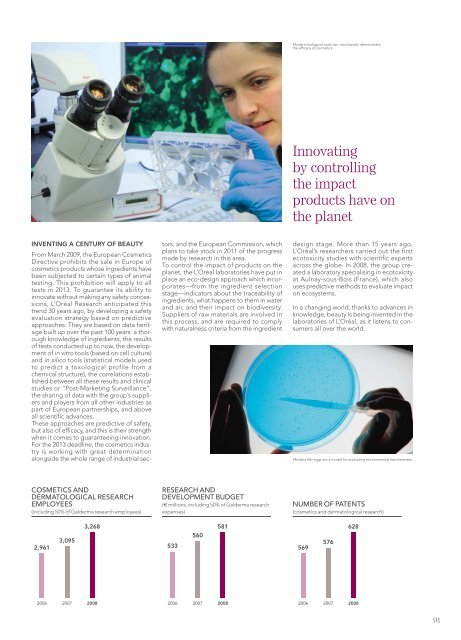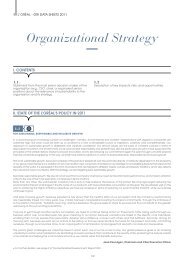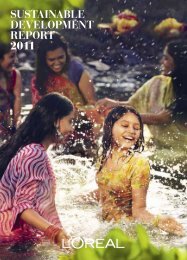2008 Annual Report - Sustainable Development - L'Oréal
2008 Annual Report - Sustainable Development - L'Oréal
2008 Annual Report - Sustainable Development - L'Oréal
Create successful ePaper yourself
Turn your PDF publications into a flip-book with our unique Google optimized e-Paper software.
InVEntInG A CEntuRY OF BEAutY<br />
From March 2009, the European Cosmetics<br />
Directive prohibits the sale in Europe of<br />
cosmetics products whose ingredients have<br />
been subjected to certain types of animal<br />
testing. This prohibition will apply to all<br />
tests in 2013. To guarantee its ability to<br />
innovate without making any safety concessions,<br />
L’Oréal Research anticipated this<br />
trend 30 years ago, by developing a safety<br />
evaluation strategy based on predictive<br />
approaches. They are based on data heritage<br />
built up over the past 100 years: a thorough<br />
knowledge of ingredients, the results<br />
of tests conducted up to now, the development<br />
of in vitro tools (based on cell culture)<br />
and in silico tools (statistical models used<br />
to predict a toxological profile from a<br />
chemical structure), the correlations established<br />
between all these results and clinical<br />
studies or “Post-Marketing Surveillance”,<br />
the sharing of data with the group’s suppliers<br />
and players from all other industries as<br />
part of European partnerships, and above<br />
all scientific advances.<br />
These approaches are predictive of safety,<br />
but also of efficacy, and this is their strength<br />
when it comes to guaranteeing innovation.<br />
For the 2013 deadline, the cosmetics industry<br />
is working with great determination<br />
alongside the whole range of industrial sec-<br />
cosMetics and<br />
derMatoloGical research<br />
eMployees<br />
(including 50% of Galderma research employees)<br />
2,961<br />
2006<br />
3,095<br />
2007<br />
3,268<br />
<strong>2008</strong><br />
tors, and the European Commission, which<br />
plans to take stock in 2011 of the progress<br />
made by research in this area.<br />
To control the impact of products on the<br />
planet, the L’Oréal laboratories have put in<br />
place an eco-design approach which incorporates—from<br />
the ingredient selection<br />
stage—indicators about the traceability of<br />
ingredients, what happens to them in water<br />
and air, and their impact on biodiversity.<br />
Suppliers of raw materials are involved in<br />
this process, and are required to comply<br />
with naturalness criteria from the ingredient<br />
research and<br />
developMent budGet<br />
(€ millions, including 50% of Galderma research<br />
expenses)<br />
533<br />
2006<br />
560<br />
2007<br />
581<br />
<strong>2008</strong><br />
Modern biological tools can conclusively demonstrate<br />
the efficacy of cosmetics.<br />
Innovating<br />
by controlling<br />
the impact<br />
products have on<br />
the planet<br />
design stage. More than 15 years ago,<br />
L’Oréal’s researchers carried out the first<br />
ecotoxicity studies with scientific experts<br />
across the globe. In <strong>2008</strong>, the group created<br />
a laboratory specialising in ecotoxicity<br />
at Aulnay-sous-Bois (France), which also<br />
uses predictive methods to evaluate impact<br />
on ecosystems.<br />
In a changing world, thanks to advances in<br />
knowledge, beauty is being invented in the<br />
laboratories of L’Oréal, as it listens to consumers<br />
all over the world.<br />
Medaka fish eggs are a model for evaluating environmental harmlessness.<br />
nuMber of patents<br />
(cosmetics and dermatological research)<br />
569<br />
2006<br />
576<br />
2007<br />
628<br />
<strong>2008</strong><br />
91






